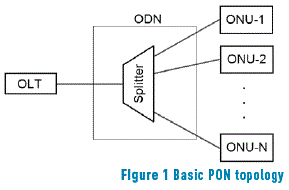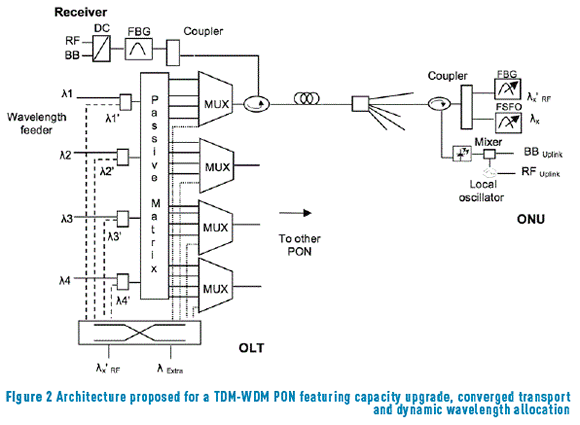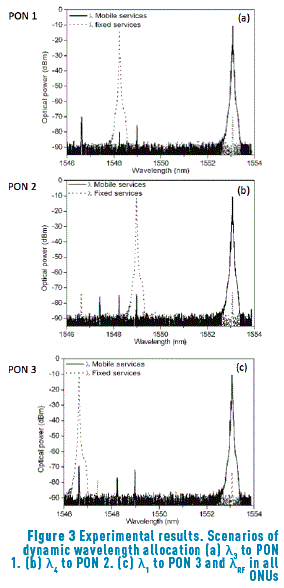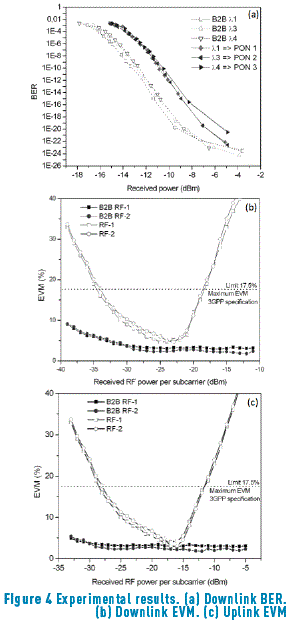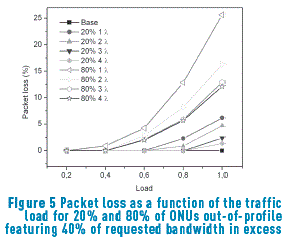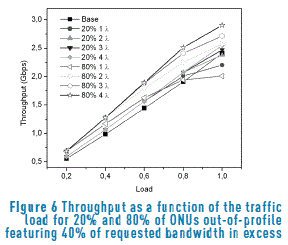Services on Demand
Journal
Article
Indicators
-
 Cited by SciELO
Cited by SciELO -
 Access statistics
Access statistics
Related links
-
 Cited by Google
Cited by Google -
 Similars in
SciELO
Similars in
SciELO -
 Similars in Google
Similars in Google
Share
Revista Facultad de Ingeniería Universidad de Antioquia
Print version ISSN 0120-6230
Rev.fac.ing.univ. Antioquia no.78 Medellín Mar. 2016
https://doi.org/10.17533/udea.redin.n78a14
DOI: 10.17533/udea.redin.n78a14
ARTÍCULO ORIGINAL
Dynamic WDM-TDM access networks featuring wired-wireless convergence
Red de acceso WDM-TDM dinámica con convergencia fija-inalámbrica
Elkin Fabián Aguas-Martínez, Gustavo Adolfo Puerto-Leguizamón*, Carlos Arturo Suárez-Fajardo
Laboratorio de Ingeniería de Microondas, Electromagnetismo y Radiación (LIMER), Facultad de Ingeniería, Universidad Distrital Francisco José de Caldas. Carrera 8 # 40-62. C. P. 110231. Bogotá, Colombia.
* Corresponding author: Gustavo Adolfo Puerto Leguizamón, e–mail: gustavo.puerto@gmail.com
ISSN 0120–6230
e–ISSN 2422–2844
(Received June 7, 2015; accepted September 9, 2015)
ABSTRACT
Growth in the use of devices with Internet access and migration of telecommunications to Internet Protocol (IP) technology has made the bandwidth demanded by users appear for the first time as a limited resource. Optical fiber is demonstrating to be the solution to this issue based on the capability to provide enough bandwidth to manage large volumes of data at high speed featuring low loss transmission. Passive Optical Networks (PON) are presented as an alternative with respect to conventional copper-based access networks due to the use of distribution passive elements, which have a lower maintenance cost as compared to the active counterpart. In addition, the optical fiber capacity provides a future-proof platform to support the forthcoming bandwidth requested in the access segment. This paper presents and demonstrates through practical and simulation data analysis a proposal for next generation PON based on Time Division Multiplexing (TDM) and Wavelength Division Multiplexing (WDM). Complying with a typical PON power budget, the architecture envisages dynamic wavelength allocation and converged transport of wired and wireless services on a unified optical platform architecture.
Keywords: Capacity upgrade, convergence, dynamic architecture, passive optical network
RESUMEN
El crecimiento en el uso de dispositivos con acceso a Internet y la migración de las telecomunicaciones basadas en la tecnología del Protocolo de Internet (IP) han hecho que el ancho de banda demandado por los usuarios se considere por primera vez en mucho tiempo un recurso limitado. Ante este problema la fibra óptica está demostrando ser la mejor solución para el transporte de información debido a su capacidad de proveer suficiente ancho de banda con bajas pérdidas para el manejo de grandes volúmenes de datos a gran velocidad. Las redes ópticas pasivas se presentan como una alternativa con respecto a las redes de acceso convencionales basadas en cobre debido al uso de elementos pasivos, los cuales presentan un menor costo de mantenimiento en comparación a su contraparte activa. Además, la capacidad de transmisión que soporta la fibra óptica permite el establecimiento de plataformas de red para dar respuesta a los requerimientos de ancho de banda futuros en el segmento de acceso. Este artículo presenta y demuestra experimentalmente y mediante simulación una propuesta para la próxima generación de redes ópticas de acceso pasivas basadas en acceso múltiple por división de tiempo y longitud de onda. Con base en el balance de potencia óptica, la arquitectura prevé asignación dinámica de canales y transporte convergente de servicios fijos e inalámbricos sobre una arquitectura óptica unificada.
Palabras clave: Aumento de capacidad, convergencia, arquitectura dinámica, red óptica pasiva
1. Introduction
PON allow the distribution of optical fiber to multiple users without the requirement of using active devices that need external power sources. A PON makes use of one wavelength for downstream and one for upstream to distribute different services [1]. Due to the existing bandwidth demands and the forecasted for future years, deployment of PON has been increasing in the last decade. A way to foresee what type of technology will be used or implemented in the future relies on making an analysis of the demanded services supported by that technology or the demand of the technology itself. In this context, both fixed and mobile traffic are important for a study on PON. A feasible source of service demand statistics related to PON networks is provided by the Cisco forecast traffic analysis [2, 3]. Cisco forecast data presents information of fixed Internet, managed IP and mobile data, showing not only a growing behavior but an exponential growth of IP traffic for fixed Internet and mobile data from 2014 to 2019. By fixed Internet is meant any IP connection from homes, campus, companies, premises and government. Managed IP is related to data traffic from corporative networks, IP television and on demand video. Mobile data covers all the data traffic from smartphones, tablets and Machine-to-Machine (M2M) devices. Doing a more technical reference, the average IP traffic in 2014 was 60 exabytes per month and is expected to reach 168 exabytes per month by 2019 and 414 terabytes per second in a global scale [2]. Some factors that influenced this forecast are the deployment and adoption of Fiber-to-the-Home (FTTH) and High-speed Digital Subscriber Line (HDSL), cable broadband adoption and overall broadband penetration. Thanks to the growing number of mobile devices, mobile technology represents a high percentage of the total traffic generated, but is FTTH the technology that presents the highest percentage of traffic generated, considering it takes the optical fiber directly to end users to distribute triple-play services (television, voice and data). As the network traffic continues to grow, it is reasonable to think about implementing access networks with more capabilities and higher bandwidth to support the future traffic demands. WDM-TDM PON networks are a possible solution to manage big amounts of traffic in the access segment while provides a unified platform for the combined transport of wireless and fixed services. Such hybrid architecture might emerge as a viable access solution where the optical network provides flexible high capacity backhaul to mobile end users [4-6].
In this scenario, two important aspects have to be considered: the increment of network capacity that the network has to undergo in order to transport higher bandwidths from both mobile and fixed users, and the flexibility in order to allocate the wavelength channels according to the demand. This feature allows better resource utilization of the network by enabling load balancing and resilience characteristics [7]. This paper describes the proposal, experimentally demonstrates a WDM-TDM PON system featuring the above-mentioned requirements, namely: increment of capacity and dynamic converged wired and wireless transport, and determines the impact of such features in the global network performance by means of simulations.
2. Materials and methods
The physical topology of an optical access network in the downstream link is Point to Multipoint (P2MP) and uses passive power splitters for distributing content to multiple users. Regardless the multiplexing technique used, Figure 1 represents a PON basic topology. PON systems consist of an Optical Line Termination (OLT), which is also known as optical line terminal. Some of the most important functions of the OLT are the traffic scheduling, bandwidth allocation and buffering control [8]. The Optical Distribution Network (ODN) based on splitters is responsible for distributing the signal generated by the service provider; this signal will be delivered to the multiple users. Finally, an Optical Network Unit (ONU) transforms the received optical signals into electrical signals that will be sent to the end user devices, e.g. phone, desktops or setup box.
In a PON architecture, the information transmitted from the OLT is considered as a broadcast signal. The signal reaches all the ONUs after the power splitting process; this is the reason why PON standards describe security mechanisms to ensure that users are allowed to access only the data intended for them. Nowadays, the most deployed PON standard is based on the Gigabit capable PON (G-PON) framework, which is known as G-PON Service Requirements (GSR) and summarizes the operational characteristics that service providers expect from the network [9]. In the context of the standard, GPON specifies access data rates of 1.244 Gb/s and 2.488 Gb/s in the downstream whereas the data rates in the upstream include 155 Mb/s, 622 Mb/s, 1.244 Gb/s and 2.5 Gb/s. As far as the wavelength channels are concerned, the downstream is transported in optical channels from 1480 nm to 1550 nm and the upstream from 1260 nm to 1360 nm.
Taking as a baseline this static architecture, our approach proposes an upgrade at both OLT and ONU. The proposal for a WDM-TDM PON network featuring capacity upgrade and supporting both dynamic wavelength allocation and convergent transport of fixed and mobile services is shown in Figure 2. The architecture allows the broadcast of multiplexed wavelengths (WDM) from the OLT to the ONU belonging to the same PON. The wavelength assigned to a given PON can be changed over time, if its capacity does not suffice the current demand (TDM). The key feature of the approach is the ability to dynamically manage wavelength channels for both fixed and wireless services.
In particular, for each wavelength channel assigned to fixed services (λx), another wavelength channel can be allocated for wireless services (λx'). In addition, an extra wavelength (λExtra) can be assigned to a single PON. Another key aspect of the approach is based on the fact that unlike the proposal described in [10], our system reuses the current PON deployment, i.e. there is no need for upgrades of the physical infrastructure (fiber and splitters) installed in the network. This feature allows a seamless way to evolution over the years.
The combination of a passive matrix and a multiplexer based on an Arrayed Waveguide Grating (AWG) in the OLT allows the even distribution of the wavelengths channels between several PON. An optical switch placed between the wavelength feeders and the multiplexer provides a mechanism to assign optical channels for both capacity upgrade and converged transport purposes. After fiber transmission and a 1:64 splitting ratio, the downstream signal reaches the ONU where an optical coupler splits it in two in order to recover the wireless and wired wavelengths.
For the wireless traffic a tunable Fiber Bragg Grating (FBG) filters out from the downstream the signals (λx'), whereas for the wired data, a tunable free spaced Fourier Optics based Optical Filter (FSFO) selects one of the possible wavelengths (λx). In both cases, the wavelength allocation is dynamic as each ONU can be assigned with different wavelength channels. Note that for a multichannel operation a set of FBG should be used in order to extract the wireless services transported in different wavelengths. In the upstream, a single wavelength is shared between the users in a PON, and convergent traffic is transported using Radio over Fiber (RoF) techniques where wireless and wired signals are electrically multiplexed and optically modulated [11, 12]. Direct modulation and Time Division Multiplex Access (TDMA) are considered for the uplink. After fiber transmission the signal reaches the OLT where a FBG removes one of the sidebands of the upstream signal in order to avoid carrier suppression effects, then, Down Conversion (DC) of the wireless signal and direct detection of both wired and wireless signals is performed.
2.1. Implementation details
Four wavelengths (λ1=1546.64 nm, λ2= 1547.44 nm, λ3=1548.24 nm and λ4=1549.04) spaced 0.8 nm and emitted at 5 dBm were used in the experimental demonstration. The extra wavelength λExtra is centered at 1549.86 nm and λRF (λx') is 1553.08 nm, which correspond to the next upper Free Spectral Range (FSR) of the 1X8 AWG. The four multiplexed wavelength channels for wired services convey 10 Gb/s traffic Non Return to Zero (NRZ) encoded and the wavelength for the transport of wireless services conveys two channels of 10 MBauds, Quadrature Phase Shift Keying (QPSK) modulated onto 2310 MHz and 2320 MHz respectively. For the uplink, all the ONUs share the same wavelength centered at 1532.7 nm that conveys 2.5 Gb/s combined with and two subcarriers (SCM) with 5 Mbauds QPSK modulated onto 1950 MHz and 1960 MHz respectively. FBG filters featuring a bandwidth of 20 GHz were used to separate the wavelength channel that transports the wireless data (λx'). While a stretching mechanism enabled FBG tunability to λRF, thermal control was used to assure stable operation on this wavelength. For demonstration purposes, the fixed channels were recovered by using a bulk tunable (FSFO) filter with a band-pass of 25 GHz.
After 20 km of optical transmission through Standard Monomode Fiber (SMF) and a 1:64 splitting ratio, the measured losses were close to 25 dB. The budget was 33 dB based on the transmission power of 5 dBm and the typical PON class B+ reception sensitivity of -28 dBm.
3. Results and discussion
3.1. Experimental results
Figure 3 depicts a scenario demonstrating the operation and feasibility of the proposed architecture. The scenario shows the wavelength channel selection in ONUs belonging to different PONs. In particular, the wavelength allocation in ONU 1 at three different PONs is shown. PON 1 has been assigned with λ3, PON 2 with λ4 and PON 3 with λ1. λRF is allocated to all the ONUs in the three PONs. Note that this assignation is dynamically allocated, which means that depending on the bandwidth demand the assigned wavelength to a given ONU can be changed.
The signal degradation for the downlink and uplink was measured for wired and wireless services. For the experimental evaluation, the signal quality in ONU 1 at three different PONs were performed under a dynamic wavelength allocation environment following the scenario described above.
Figure 4 shows the quality of the downstream signal. In particular, Figure 4(a) shows the Bit Error Rate (BER) performance of the examined wired services showing in all cases a penalty of approximately 2 dB for 1x10-12 BER compared to the back-to-back curve. Note that the BER floor is found for received powers higher than -6 dBm and no noticeable differences are found in the BER curves measured at different ONUs. We paid particular attention to the performance offered to the transmission of wireless services. For a total optical budget of 33 dB, the Error Vector Magnitude (EVM) was measured as a function of the received power for the two wireless channels transported. The EVM is a measure of the difference between the transmitted symbols and the measured symbols after the reception process.
Figure 4(b) shows the quality of the wireless services in the downlink direction; degradation of the two channels QPSK separated 10 MHz was measured showing that an EVM power margin of 17 dB is feasible. The power margin is defined as the difference between the maximum and minimum received RF power that fulfils the EVM limit value. In particular, for the 3rd Generation Partnership Project (3GPP) Universal Mobile Telecommunications System (UMTS) and Long Term Evolution (LTE) using QPSK modulation, the EVM limit is 17.5% [13], this limit can be seen in Figure 4(b). In the uplink direction, an EVM power margin for the same limit value results in an EVM margin of 14dB as observed in Figure 4(c). Please note that the limit of 17.5% is defined to be the maximum EVM measured at the end of the air link, therefore a lower limit value of this parameter should be targeted at the output of the RoF system as the signals still have to propagate through the air link. This proposal considers an EVM limit of 8%, by doing so the power margin is 8.5dB. It should be noticed that in the downlink direction, an EVM margin threshold lower than 17.5% is not considered because the signal measurement is performed after radio transmission. The optimum received RF power is -24dBm for EVM of 4.5% in the downlink and -16dBm for 3.5% in the uplink. While at low received powers the EVM is degrading due to the reduction of the signal to noise ratio, at powers higher than -18 dBm the penalty is due to the cross talk from the adjacent channel in the filtering process at the ONUs. Also note that the received powers for the downlink and uplink were different. This is caused by the transmission method used at both transmitters, while external modulation was used in the downlink, the uplink was based on direct modulation of the laser as seen in Figure 2. This fact results in penalties for the uplink signals so that additional 6 dB are needed over this link to reach a performance similar to the downlink.
3.2. Modeling results
This section presents the performance of a WDM-TDM PON network in terms of adaptation to demanding data traffic requests. In this context, the benefit of upgrading the system capacity, i.e. broadcast additional wavelength channels contributing to extra-bandwidth in the network is evaluated by means of a teletraffic analysis performed in the environment of the Network Simulator (NS2). For the sake of the evaluation, a significant scenario has been configured in which a percentage of out-of-profile ONUs and the amount of traffic in excess requested by them were defined. For this purpose, 20% and 80% of out-of-profile ONUs were evaluated. An out-of-profile ONU means that the aggregated bandwidth (in excess) requested by the users belonging to that ONU is higher than the provided in the steady state. In this scenario the base bandwidth is 79 Mb/s per ONU, which means that 2.5 Gb/s were transmitted from the OLT and broadcasted to 32 users. Figure 5 shows the packet loss as a function of the traffic load for the base scenario, i.e. all the ONUs are in-profile.
The traffic load is defined as the ratio between the number of bits transmitted per time unit and the link data rate. The figure includes the results for a TDM-WDM operation featuring 20% and 80% of ONUs out-of-profile with an exceeding traffic of 40% above the steady state. As seen, for a traffic load of 1, when only one wavelength is used in the network and 20% of ONUs are out-of-profile, the packet loss percentage is around 5%, whereas for 80% of ONU out-of-profile the packet loss is roughly 26%. However, when an extra-wavelength with its associated bandwidth is used, the packet loss drops to 4.6% and 17.3% for 20% and 80% of ONUs out-of-profile respectively.
For medium and low traffic load values, the contribution of having extra wavelengths for 20% of ONUs out-of-profile is nearly negligible while more significant when the amount of ONUs misbehaving is higher, e.g. 80%.
The contribution of extra-wavelengths to the throughput for the above-described scenario is shown in Figure 6. In general, the throughput in all wavelengths behaves linearly for all the traffic loads except for the configuration with one wavelength, which at a high load (>0.8) due to the packet loss as seen in Figure 5, produces a reduction of the system throughput. In this context, the packet loss is caused by an overflow in the buffers used in the receiving side. For 2, 3 and 4 wavelengths, as the packet loss is reduced, the throughput is incremented reaching a net value of approximately 2.85 Gb/s for the case of three extra-wavelengths in a network with the 80% of ONUs out-of-profile and nearly 2.67 Gb/s for 20% of ONUs out-of-profile. It represents roughly a 6% and a 14% of additional bandwidth for 20% and 80% of ONUs out-of-profile respectively. This is a measure of how much bandwidth in excess the network is able to provide, in the event of high bandwidth requests from the ONUs. Note that the 80% of out-of-profile ONUs results in higher throughput as compared to the 20% case, this is because there are more ONUs requesting bandwidth, the throughput increases as the packet losses are not relevant; when packet losses become significant, then the throughput decreases as discussed above.
4. Conclusion
Key features of future access networks were defined, namely: capacity upgrade, convergence of wired and wireless transmission, and dynamic wavelength allocation. These key features are the basis of the WDM-TDM PON approach presented in this paper. The proposal supports the predicable evolution path of optical access networks by enabling the reuse of the current deployed fiber infrastructure. While capacity upgrade is accomplished by broadcasting several wavelengths within the PON, dynamic wavelength channel allocation is based on the selection on-demand of one of these broadcasted channels. Both features were demonstrated, however it should be pointed out that there is no practical optical filtering technology to perform fast selection today.
Combined wired and wireless transport was also demonstrated and performed by RoF techniques in both downlink and uplink directions. It was proven the capability of transporting and distributing simultaneously a multiplex of two radiofrequency subcarriers over a PON system with an optical budget of 33 dB. Considerations on the EVM limit based on the 3GPP recommendation were taken into account demonstrating that current and next generation PON infrastructures can be used as physical platforms to provide a backhaul infrastructure to fourth generation mobile systems (4G) and beyond. This fact constitutes the main use case of the proposed architecture, namely: an optical physical platform over which a telecommunications operator can distribute fixed and mobile services in the access segment. In the context of the implementation, the optical filtering was identified as the key element to enable the deployment of the future access networks since today there are no feasible photonic filters that perform neither fast wavelength selection nor selective filtering process. This fact opens the door to future works related to the design or optimization of current filtering technologies to fulfill the high demanding performance required by WDM-TDM networks conveying converged services.
This paper also presented simulations results that show how a distribution strategy on PON based on TDM-WDM results in an improvement of the network performance by reducing the packet loss and incrementing the throughput. This fact enables a better bandwidth usage.
5. Acknowledgment
The authors wish to acknowledge the Universidad Distrital Francisco José de Caldas and the Optical and Quantum Communications Group of the Universidad Politécnica de Valencia for supporting the development of this paper.
6. References
1. R. Yadav, "Passive-optical-network- (PON-) based converged access network [Invited]", IEEE/OSA Journal of Optical Communications and Networking, vol. 4, no. 11, pp. B124-B130, 2012. [ Links ]
2. Cisco, The Zettabyte Era: Trends and Analysis, 2015. [Online]. Available: http://www.cisco.com/c/en/us/solutions/collateral/service-provider/visual-networking-index-vni/VNI_Hyperconnectivity_WP.pdf. Accessed on: Mar. 20, 2015. [ Links ]
3. Cisco, Cisco Visual Networking Index: Global Mobile Data Traffic Forecast Update, 2014–2019, 2015. [Online]. Available: http://www.cisco.com/c/en/us/solutions/collateral/service-provider/visual-networking-index-vni/white_paper_c11-520862.pdf. Accessed on: Mar. 20, 2015. [ Links ]
4. G. Venkatesan and K. Kulkarni, "Wireless backhaul for LTE-requirements, challenges and options", in 2nd International Symposium on Advanced Networks and Telecommunication Systems (ANTS), Mumbai, India, 2008, pp. 1-3. [ Links ]
5. M. Ali, G. Ellinas, H. Erkan, A. Hadjiantonis and R. Dorsinville, "On the Vision of Complete Fixed-Mobile Convergence", Journal of Lightwave Technology, vol. 28, no. 16, pp. 2343-2357, 2010. [ Links ]
6. A. Buttaboni, M. de Andrade and M. Tornatore, "Dynamic bandwidth and wavelength allocation with coexistence of transmission technologies in TWDM PONs", in 16th International Telecommunications Network Strategy and Planning Symposium (Networks), Funchal, Portugal, 2014, pp. 1-6. [ Links ]
7. F. Effenberger, "PON Resilience [invited]", Journal of Optical Communications and Networking, vol. 7, no. 3, pp. A547-A552, 2015. [ Links ]
8. F. Selmanovic and E. Skaljo, "GPON in Telecommunication Network", in International Congress on Ultra Modern Telecommunications and Control Systems and Workshops (ICUMT), Moscow, Russia, 2010, pp. 1012-1016. [ Links ]
9. G. Keiser, "GPON Characteristics", in FTTX Concepts and Applications, 1st ed. Hoboken, USA: John Wiley & Sons, Inc., 2006, pp. 155-169. [ Links ]
10. A. Koonen, N. Tran and E. Tangdiongga, "The merits of reconfigurability in WDM-TDM optical in-building networks", in Optical Fiber Communication Conference and Exposition and the National Fiber Optic Engineers Conference (OFC/NFOEC), Los Angeles, USA, 2011, pp. 1-3. [ Links ]
11. G. Puerto and C. Suárez, "Analytical model of signal generation for radio over fiber systems", DYNA, vol. 81, no. 188, pp. 26-33, 2014. [ Links ]
12. K. Miyamoto et al., "Transmission Performance Investigation of RF Signal in RoF-DAS Over WDM-PON With Bandpass-Sampling and Optical TDM", Journal of Lightwave Technology, vol. 31, no. 22, pp. 3477-3488, 2013. [ Links ]
13. Rohde & Schwarz, LTE: System Specifications and Their Impact on RF & Base Band Circuits, 2013. [Online]. Available: http://cdn.rohde-schwarz.com/pws/dl_downloads/dl_application/application_notes/1ma221/1MA221_1e_LTE_system_specifications.pdf. Accessed on: Apr. 3, 2015. [ Links ]













